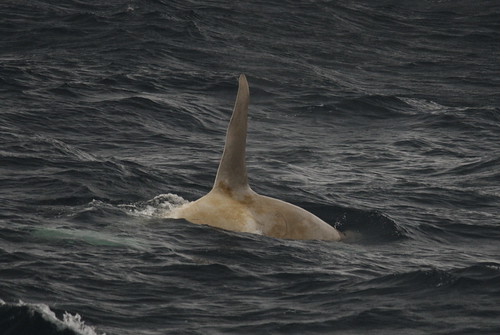tags: white orca, white killer whale, Orcinus orca, zoology, cetaceans, NOAA
A rare white killer whale, Orcinus orca, better known as an Orca,
photographed by researchers off the coast of Alaska on 23 February.
Image: Holly Fearnbach (NMML, NMFS permit 782-1719) [wallpaper size].
Seattle researchers were working off the coast of Alaska when they saw something amazing; a 25-30 foot long male "killer whale", Orcinus orca, that is white instead of being black-and-white, the characteristic color scheme for this species. This white whale, which was identified as a male due to its very tall dorsal fin, appeared to be a healthy adult weighing roughly 10,000 pounds.
"I had heard about this whale, but we had never been able to find it," said Holly Fearnbach, a research biologist with the National Marine Mammal Laboratory in Seattle who photographed the rarity. "It was quite neat to find it."
When they saw the whale, the researchers were aboard the National Oceanic and Atmospheric Administration research ship, the Oscar Dyson, conducting an acoustic survey of pollock near Steller sea lion haulout sites. The ship followed the whale through rough seas for approximately 30 minutes, with most of the scientists busily snapping pictures of the rare animal.
"Everybody actually came out and was taking pictures," Fearnbach said. "It was a neat sighting for everybody."
Some scientists argue that there are at least two distinct species of orcas; those that eat primarily fish and thus reside along the coastlines where salmon congregate, and those orcas that prey upon seals and whales, thus ranging widely through open seas and along shorelines as yhey follow their prey. The white orca that was recently photographed is the fish-eating type. Fish-eating orcas are frequently seen around the Aleutian Islands during the summer, but these winter sightings are important evidence that these orcas may be resident instead of migratory.
"With hundreds of killer whales documented around the Aleutian Islands, this was equivalent to finding a needle in a haystack," Fearnbach mentioned.
The white whale was photographed in the company of a family group, or pod, of 12 other normally-colored orcas 2 miles off the Kanaga Volcano on Alaska's Aleutian Islands on 23 February.
A rare white orca, Orcinus orca,
cavorts with its pod in rough seas off the coast of Alaska on 23 February.
Image: Holly Fearnbach (NMML, NMFS permit 782-1719) [wallpaper size].
"When you first looked at it, it was very white," Fearnbach stated.
But a closer inspection of the images reveals that this whale is not all white, as first suspected, but instead, those areas of its body that would normally be black actually are pale tan, which is consistent with leucism. Leucism is a genetic condition that causes a reduction in all skin pigmentation, but it is not true albinism, which causes a cessation of all pigment production. Thus, this whale is not atrue albino, which pleased excited researchers since albinos tend to suffer a variety of diseases and other health problems that prematurely end their lives.
White orcas have been reported in the Aleutians and in the Bering Sea as well as along the Russian coast. It is not yet known if these other sightings represent other individual orcas, or this animal.
"This is the first time we came across a white killer whale," pointed out John Durban, a research biologist at NOAA's Alaska Fisheries Science Center in Seattle.
A rare white orca, Orcinus orca,
photographed off the coast of Alaska on 23 February.
Image: Holly Fearnbach (NMML, NMFS permit 782-1719).
Sources
NOAA (images, quotes)
KomoTV (quotes).




Cool!